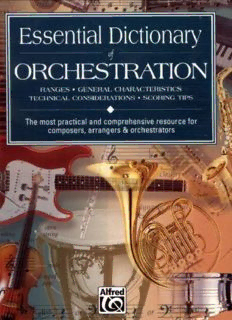
Essential Dictionary of Orchestration: The Most Practical and Comprehensive Resource for Composers, Arrangers and Orchestrators PDF
Preview Essential Dictionary of Orchestration: The Most Practical and Comprehensive Resource for Composers, Arrangers and Orchestrators
This book is organized in the following manner: 1. Alphabetized by instrument groupings: Bowed Strings About String Technique Clarinets Double Reeds Flutes Fretted Strings About Guitar Notation Harmonica Harps Horns Keyboards Percussion About Percussion Notation Non-Pitched Metals Skins Woods Pitched Electronic Glass Metals Skins Woods Saxophones Trombones Trumpets About Mutes & Articulations Tubas Voice Index 2. Alphabetized within each instrument grouping. For example: Trombones Alto Trombone Bass Trombone Contrabass Trombone European-Style Bass Trombone Slide Trumpet Tenor Trombone Valve Trombone The Essential Dictionary of Orchestration has been organized in an easy-to-use format that includes cross referencing. At the top of each page, headers show which instrument is being discussed. Bold treatments of text highlight important points for clarity and quick reference. Text is accompanied by examples directly related to each topic. These examples are as simple and complete as possible. Details specific to an instrument family are discussed thoroughly in the primary instrument of that family and are cross-referenced in other family members. The focus of this book has been narrowed in scope, in order to present as much information as possible related to the instruments themselves. The serious musician is encouraged to seek out other sources that more thoroughly address the subjects of arranging, music theory and notation. The range of most instruments is subjective and will depend on the ability level of a given individual. Written ranges presented for each instrument are based on professional levels of ability. These ranges are often extended by exceptional/virtuosic players and thus, are not included in this discussion. Practical ranges are considered a "safe" limit for each instrument. In circumstances that involve an unknown group of musicians or intermediate-level musicians, these ranges may help to ensure a more successful performance. Actual sounding ranges for transposing instruments are provided for quick reference. Where applicable, dynamic contours are indicated to show the natural increase in volume and intensity inherent in many of the instruments' registers. This symbol 1+1, included in some instrument ranges, reflects a possible extension of the range (higher or lower) for more advanced musicians. Notes in parenthesis indicate possible, but not often used, notes. About String Technique The following generalities apply to all bowed strings: ARCO STRING TECHNIQUE The term arco indicates that the string is to be bowed. •Unless otherwise indicated, arco is assumed by the player except after pizz. or when clarification is needed. •There are two primary motions associated with bowing: up-bow (V) and down- bow (n). •Upbeats are usually played with an up-bow. Downbeats, important notes and heavier notes/ accents are usually played with a down-bow. •Because they use more of the bow, louder musical situations require more bow changes than that of softer musical situations. •Except for dynamic considerations and particular effects, up-bows and down- bows are generally applied equally. •Universal agreement on articulation terminology doesn't exist among musicians-a thorough knowledge of the various techniques is needed in order to convey exactly what is wanted. On-the-string Articulations •Detache (separate bows) is the alternating of up-bows and down-bows. A passage without bowing indications would be played detache: •Legato bowing is indicated by a slur. All notes within the slur should be played with a single bow-stroke: •Portato (loure) is a series of notes within a single bow-stroke, each with a slight separation or push: • Brush stroke is not a written articulation but is asked for frequently, especially in orchestral playing. Played with separate bow-strokes, the bow comes off the string slightly, with each note gently articulated without accent. A brush stroke can be light or heavy, and performed at any tempo. The length of the stroke falls somewhere between detache and martele. •Martele (on-the-string staccato) includes the following articulations: (and (A). Marteletechnique requires that the bow begin and remain on the string with a clean separation between notes (the slurred staccato and hooked bowing are also forms of martele): •Unlike the typical on-the-string staccato which requires bow direction changes, on-the-string slurred staccato separates the notes without a directional change. Notes are more separated than when playing portato. A slurred staccato is frequently used with this rhythm: •Hooked bowing is similar to the slurred staccato except the first note is shortened to separate the notes. This articulation still uses one bow-stroke: Musical situations will usually dictate whether an on-the-string or off-the- string technique should be used. If a specific technique is desired, it must be indicated. Off-the-string Articulations •Spiccato (off-the-string staccato) requires the bow to bounce naturally off the string to achieve a fast and very light staccato effect. Unless specified, the choice between martele or spiccato is made by the performer. At very slow tempos, spiccato is an artificial bounce or a brush stroke: •Staccato volante is an up-bow spiccato that includes several notes in one bow- stroke: • Saltando is a down-bow spiccato that includes several notes in one bow-stroke. It is always accompanied by the term saltando: •Successive strokes are possible at most tempos. Multiple successive downstrokes produce an accented, heavy quality with a decided break between notes. Multiple successive up-strokes have a delicate, light quality with a clear separation between notes: •Jete (ricochet bowing) requires the bow to be dropped or thrown against the string, allowing it to bounce naturally and very rapidly. This articulation is primarily used with multiple and/or repeated notes. The terms richochet or
Description: